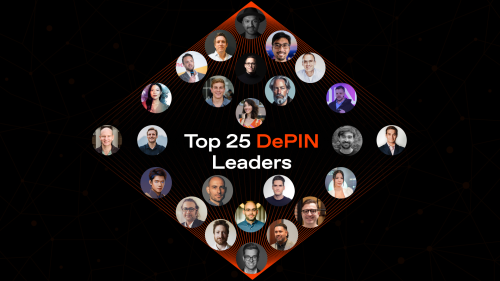Decentralized Physical Infrastructure Networks (DePINs) promise to equip emerging markets with inclusive, efficient, sustainable, and community-owned infrastructure.
What follows are untapped global resources, business growth, poverty alleviation, the adoption of other technologies, and even the protection of human rights.
Sounds like a great promise for humanity, right? We agree, which is why we devoted an entire article to the vision and potential of DePINs in emerging markets.
It’s based on our recent report on how DePIN brings business opportunities for Web3 and sets the stage for a more in-depth examination of the DePIN business.
This vision is still an idealistic dream, but it could come true. The first contours are emerging, some of them in Mexico.
Once upon a time in Mexico – top-down turned bottom-up
Helium Mobile is a mobile carrier using and facilitating the community-built, decentralized Helium 5G network. In January 2024, Helium Mobile partnered with Telefónica Mexico. With this partnership, Telefónica seeks to reduce costs and improve network coverage by using Helium’s Wi-Fi hotspots.
Those hotspots, however, are not exactly Helium’s hotspots. They belong to Helium’s users, who invest in and deploy physical hardware. Helium hotspot providers now receive 50 cents for every GB Telefónica’s customers use via their Wi-Fi hotspots.
What are emerging economies?
Economic strength, a liberalized market, and a young, tech-savvy population are typical characteristics of emerging markets. These markets have reached developed country standards in some areas, but are far from meeting all the criteria.
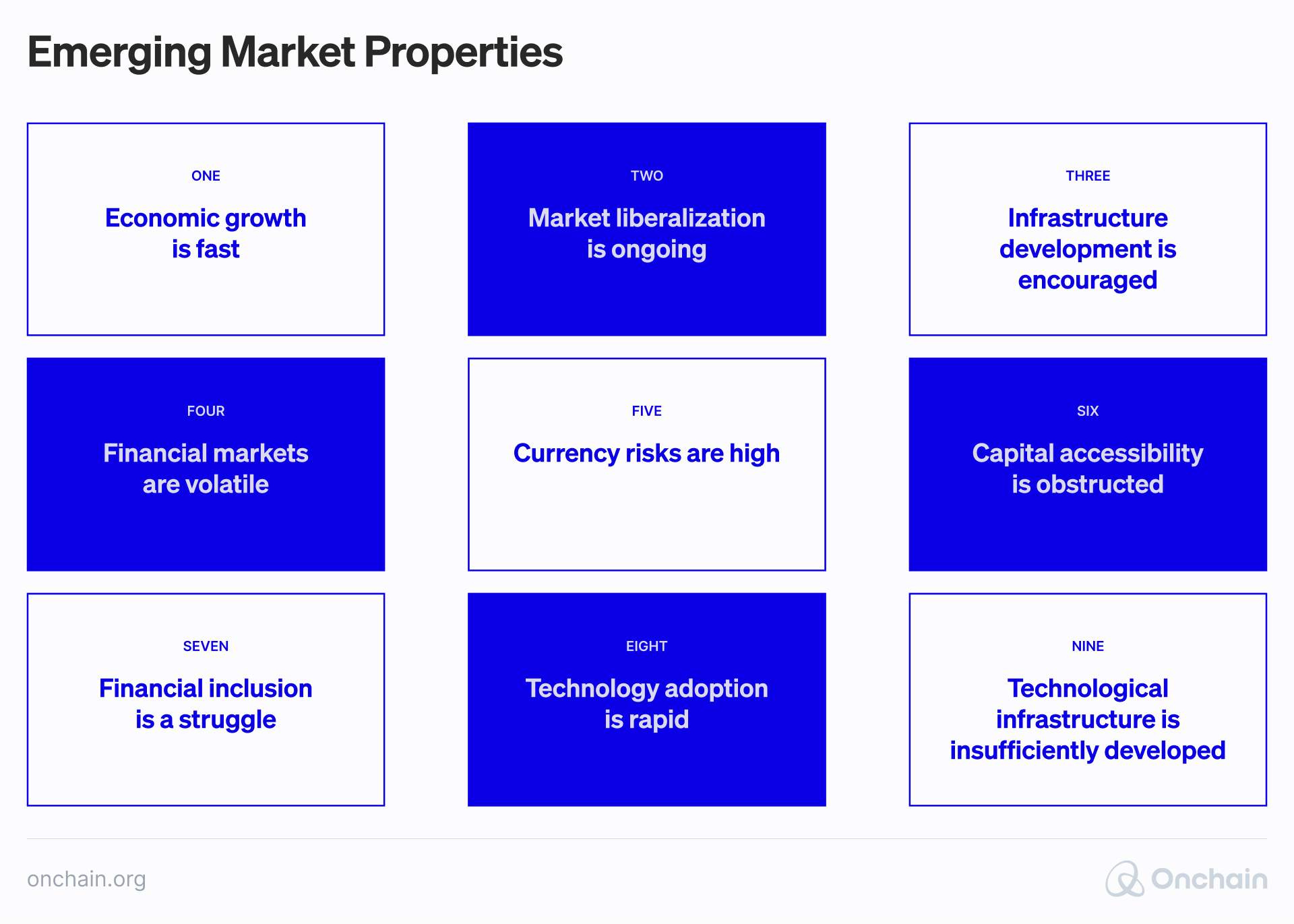
Mexico is only one example that attracts entrepreneurs with such fertile ground for business opportunities.
Other examples of emerging economies that offer similar opportunities include Brazil, India, Nigeria, Poland, and the Philippines.
What exactly is DePIN?
DePINs are Web3 projects that incentivize people and companies to build infrastructure and plug it into a larger network.
As such, it enables everyday people and SMEs to be part of a process that was before reserved for large, centralized organizations such as Telefónica Mexico.
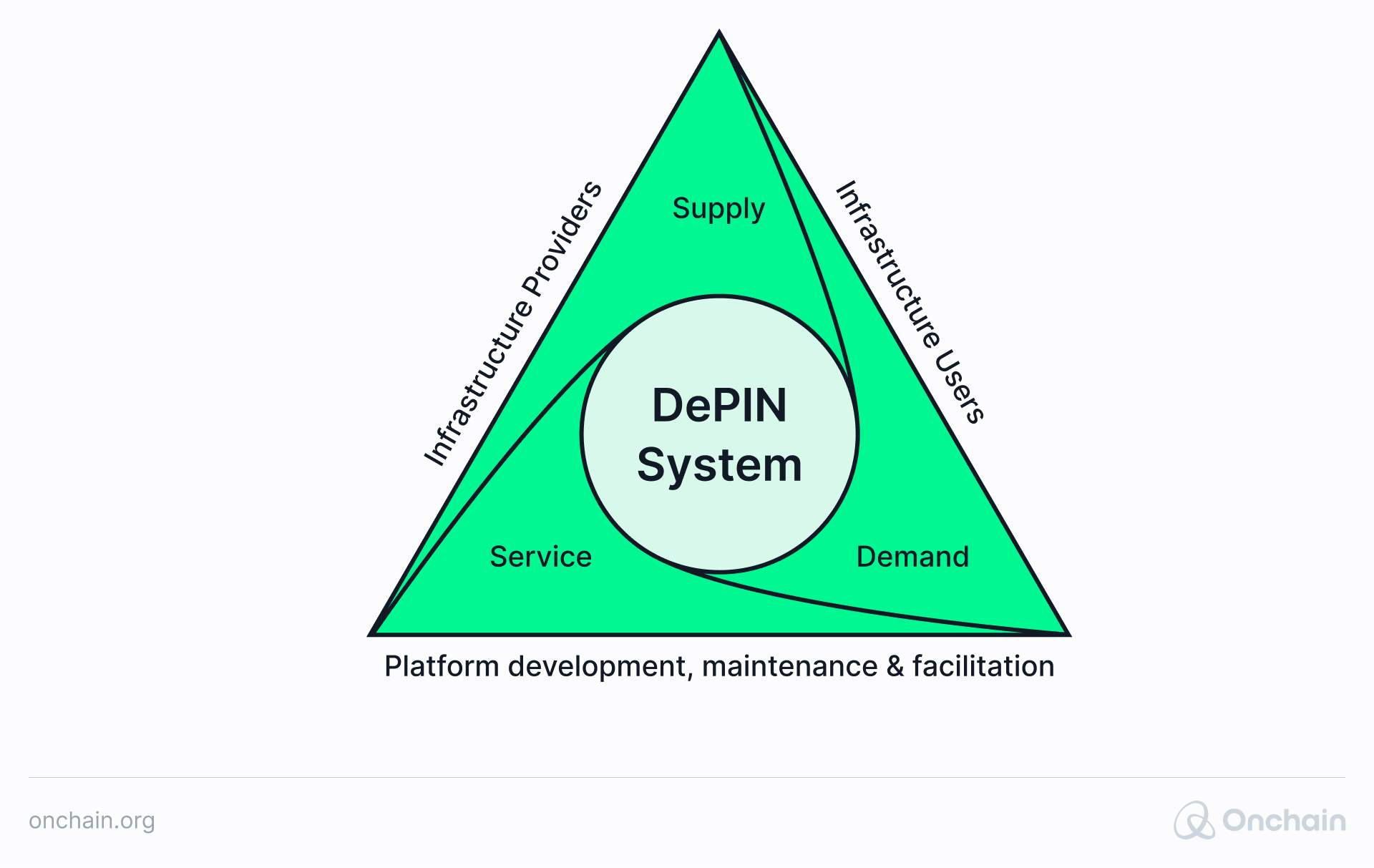
The shareholders of DePIN are the platform developers (facilitators) and the platform users. Users include infrastructure providers (supply side) and end-users (demand side).
Together, they form a self-managed organization built on a blockchain network.
How to make money with DePIN – The DePIN business model
DePIN platforms earn commissions on peer-to-peer transactions. Other sources include API accesses, on-chain data sales, subscriptions, and token value growth.
Our report provides more details about the DePIN business model, including the most popular and most effective revenue streams, cost factors, and competitive landscape analysis.
Infrastructure providers earn the platform token by building and running infrastructure. First, these tokens are incentives from the platform. Then, end-users create a sustainable revenue stream. This new demand will then attract more infrastructure providers.
This process, the DePIN flywheel effect, is a challenge for all DePIN projects.
DePIN examples
- Community-run wireless networks – Helium
- Distributed computing power – Akash
- Decentralized storage capacity – Filecoin
- Improving sensor data collection – DIMO
- Peer-to-peer renewable energy trading – Powerledger
To get the flywheel turning, DePIN needs challenges worth overcoming. Let’s take a look at some of them.
What are the challenges of emerging economies?
In most emerging economies, we find a tech-savvy population on one side – and an underdeveloped technological infrastructure on the other. But there is more.
Many emerging and frontier markets rank low in Transparency International’s Corruption Index.
At the same time, individuals and SMEs must navigate resource-constrained environments.
Time to bring DePIN on stage.
Why DePIN for emerging markets is a great idea
To answer the headline, we need to understand the dynamics between blockchain properties and critical real-world infrastructure in emerging markets.
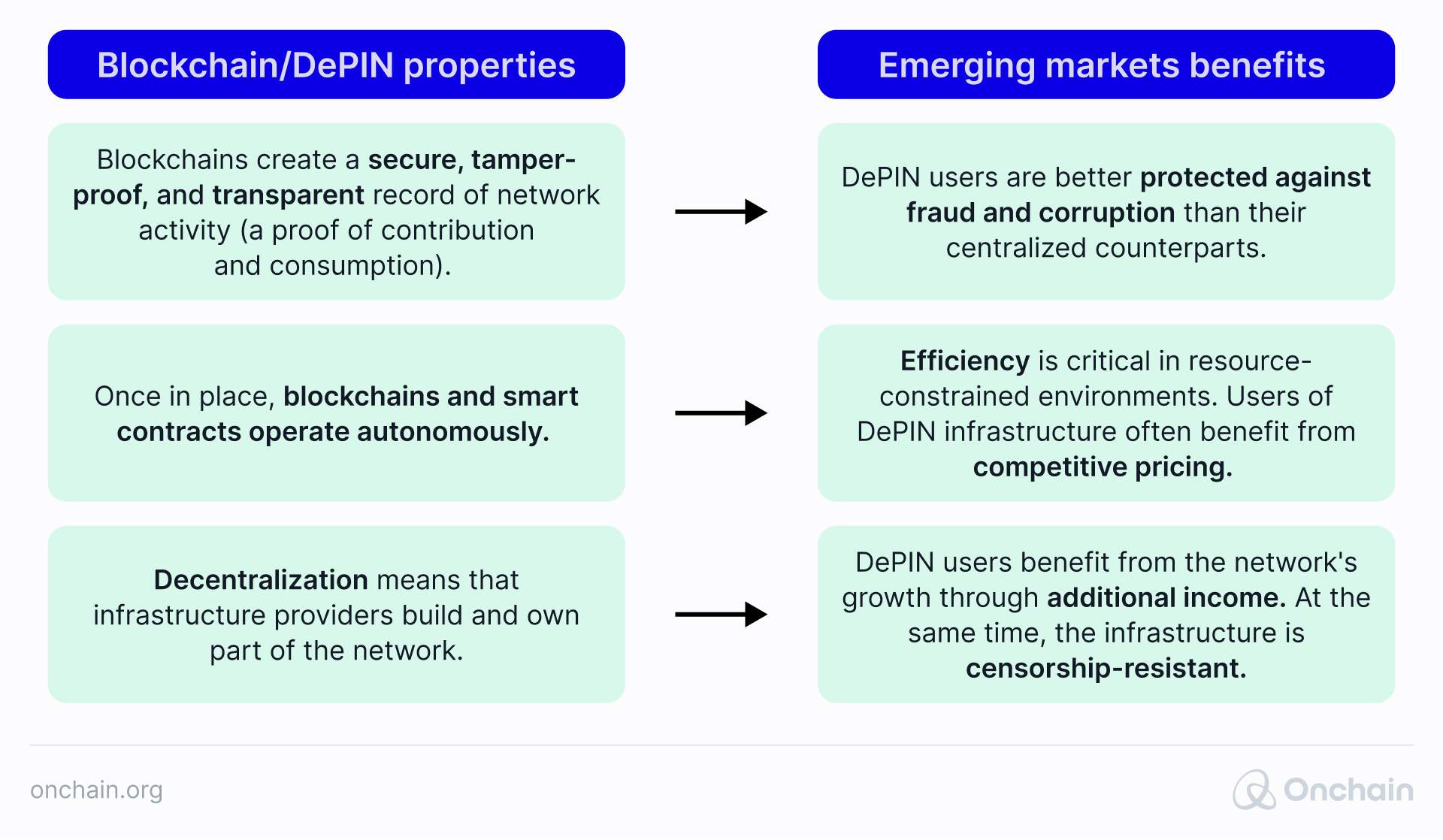
Great ideas deserve a reality check. Next, we examine some real-world examples of DePIN projects.
How can DePIN help emerging markets?
In this section, we will cover how DePIN can
- tap into global, idle resources.
- facilitate technical infrastructure development.
- protect human rights.
- reduce poverty through alternative incomes.
(1) How DePIN taps into global, idle resources
Our world is full of untapped resources. DePIN platforms that connect idle supply with demand create a win-win situation – inclusive, efficient, and sustainable.
Think of idle GPUs, smartphone cameras, and sensors. Tapping into them lowers prices and is also greener than building more infrastructure.
Since resource scarcity is one of the biggest challenges for emerging markets, removing this obstacle is also a great opportunity to facilitate business growth.
This works best when resources are not constrained by location. Computing power is a prime example.
Akash is a decentralized computing marketplace that connects GPU power lenders with businesses and individuals in need. It offers computing power up to five times cheaper than AWS.
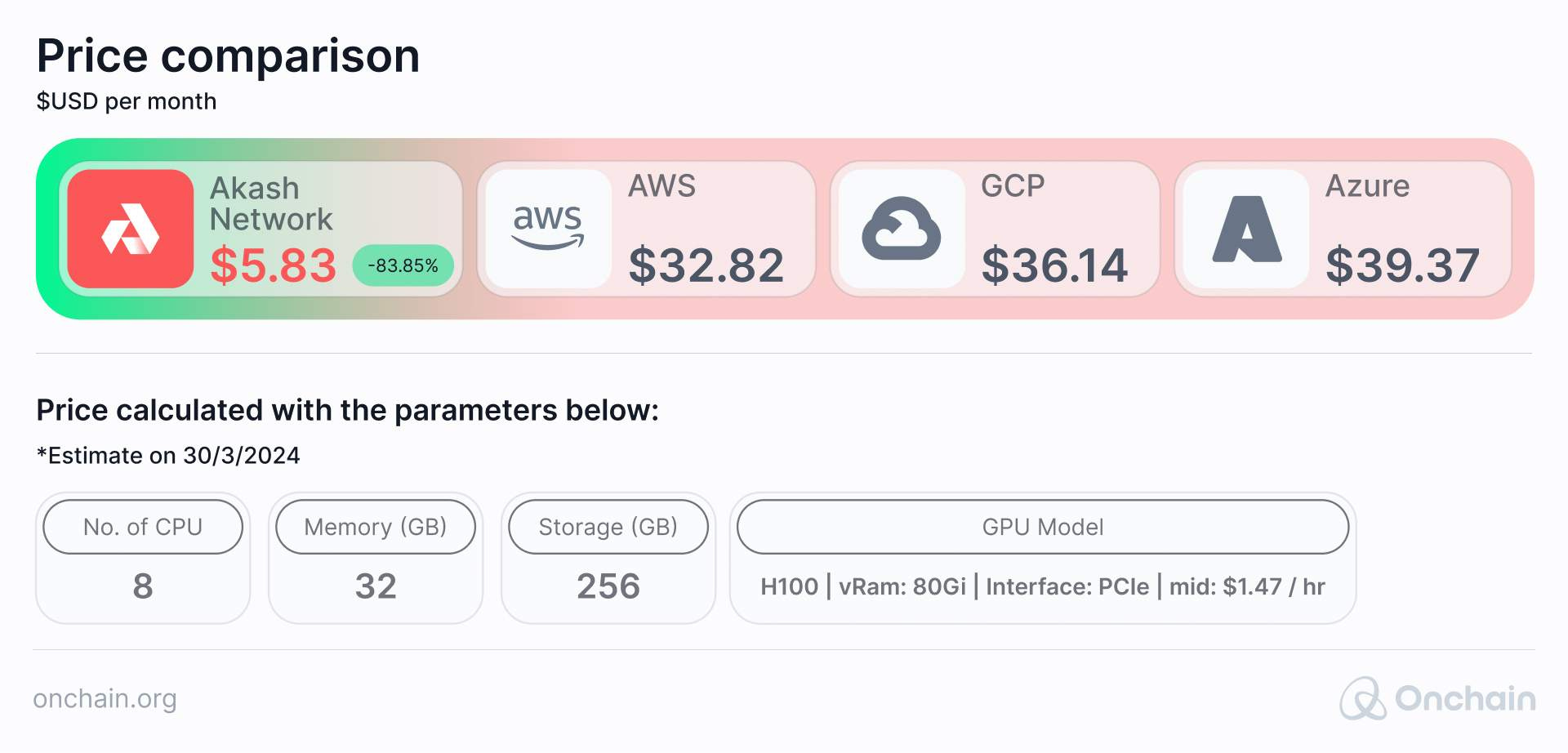
Competitive pricing for computing power itself can help reduce inflation. It also makes other deflationary technologies like AI more accessible.
(2) How DePIN facilitates infrastructure development
While Akash makes computing power accessible, other projects like Helium are trying to create a widespread network of WiFi and IoT hotspots for their decentralized wireless services.
The demand and the trajectory are there. Helium’s strategy addresses the shortcomings of the existing centralized market. Only about 66% of the global population, 5.35 billion people, can access the internet. This number is set to increase to 7.9 billion by 2029.
The caveat to projects like Helium is that it requires providers to invest in expensive hardware. An obstacle in developing countries.
As a result, most, but not all, of Helium’s 150,000 hotspots exist in developed countries, where they compete with centralized connectivity providers.
However, the potential of decentralized infrastructure extends beyond competition. It can serve as a guardian of human rights.
(3a) How DePIN protects Human Rights and prevents internet shutdowns
“Everyone has the right to freedom of opinion and expression; this right includes freedom to hold opinions without interference and to seek, receive and impart information and ideas through any media and regardless of frontiers.”
Article 19 – Universal Declaration of Human Rights
On July 7, 2021, the Human Rights Council issued a resolution to promote human rights on the Internet. It includes the right to freedom of expression and condemns Internet shutdowns and online censorship.
One year later, governments in 35 countries flipped the kill switch. In response to riots and protests, governments are using Internet access as a weapon against their own people.
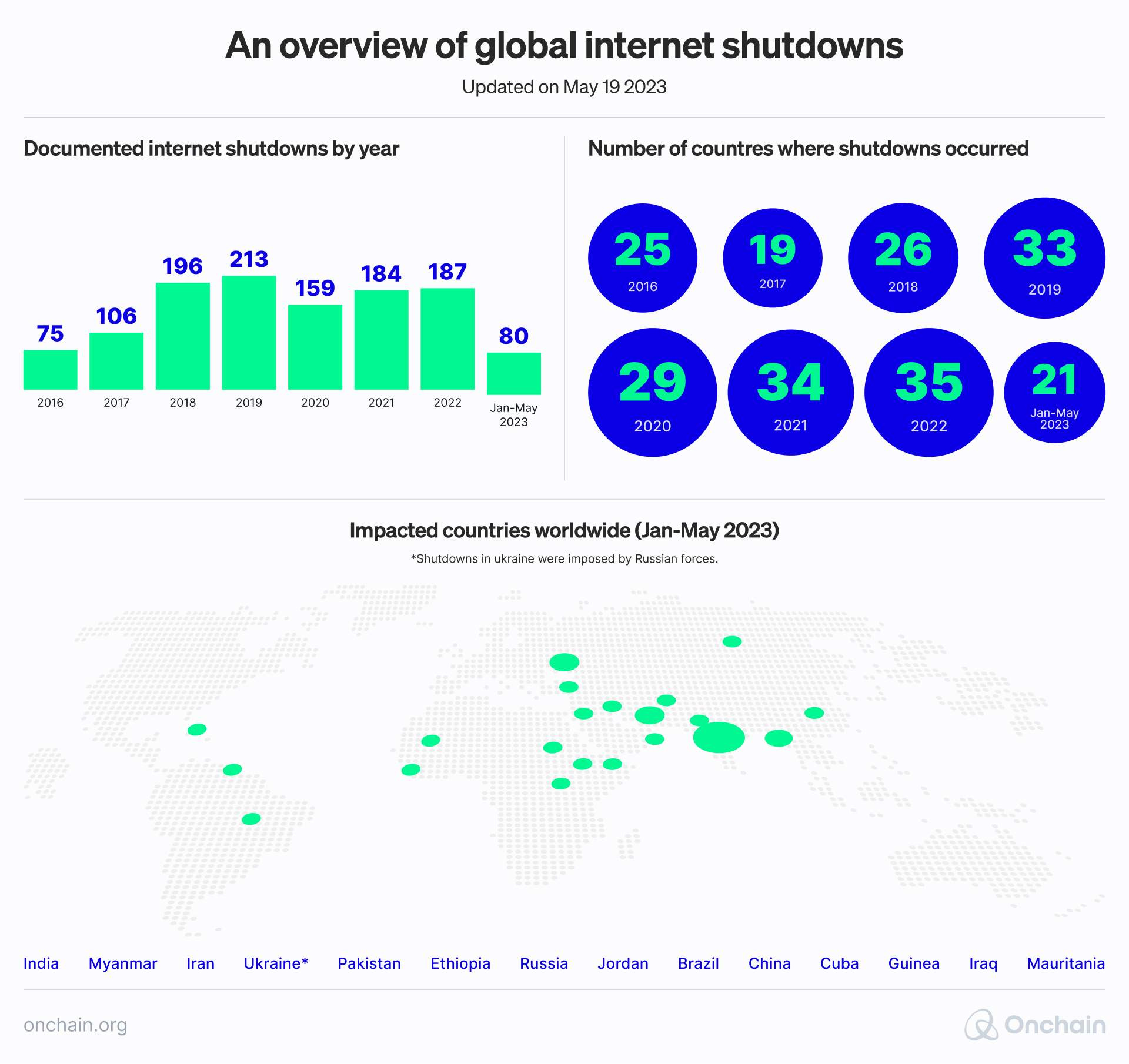
It is a sad trend. But DePIN is a beacon of hope against digital authoritarianism.
There is no kill switch for decentralized infrastructure. And our freedom of expression is worth protecting – as is privacy.
(3b) How DePIN protects the right to privacy
“No one shall be subjected to arbitrary interference with his privacy, family, home or correspondence, nor to attacks upon his honour and reputation. Everyone has the right to the protection of the law against such interference or attacks.”
Article 12 – Universal Declaration of Human Rights
Censorship, data logging, and surveillance are the sad reality for many people.
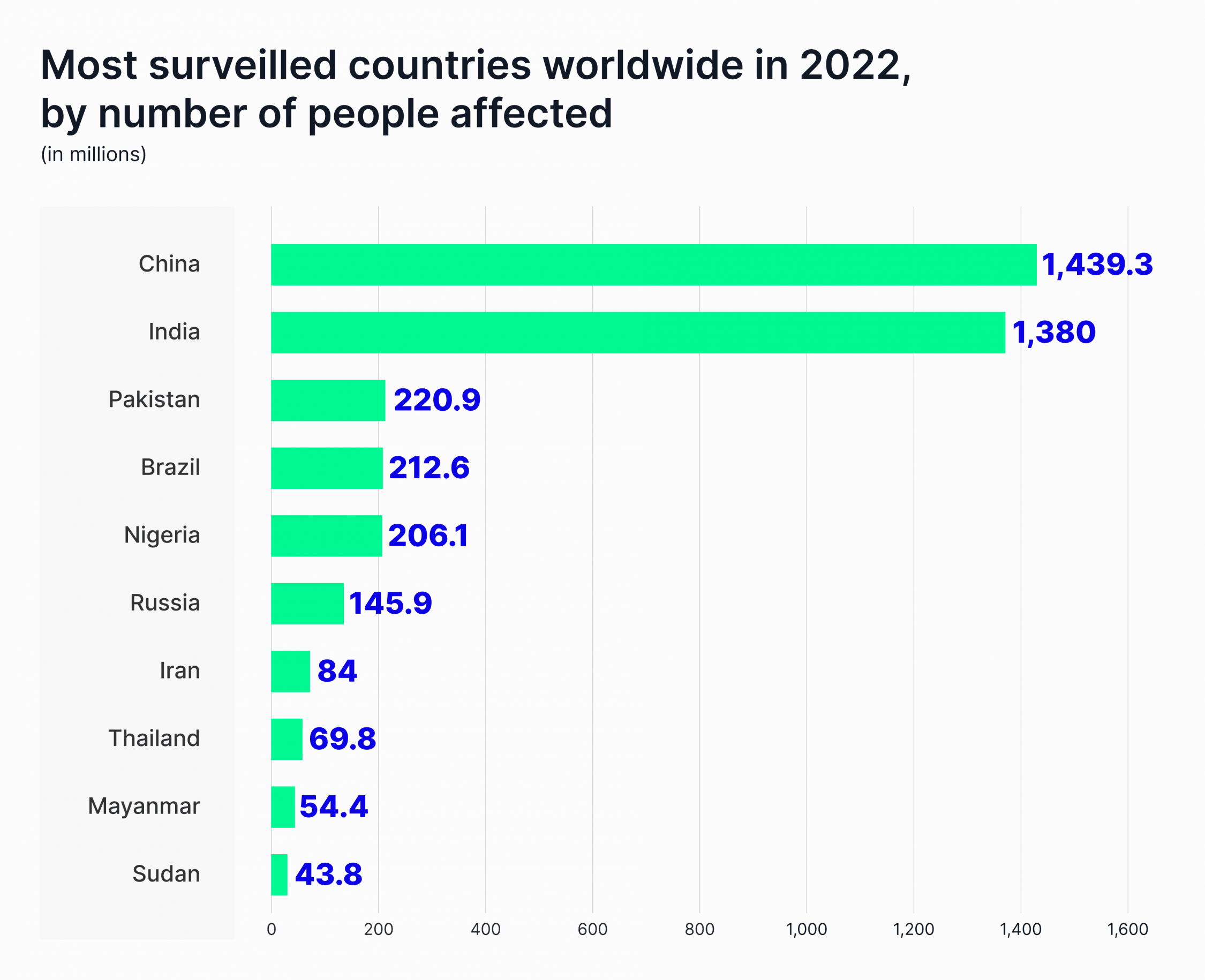
Citizens protect themselves with privacy tools such as VPNs. However, authorities are already targeting the centralized servers that run these VPNs.
But they can’t target the decentralized architecture of decentralized peer-to-peer VPNs like Orchid. The project allows individual providers to sell their own servers as VPN nodes.
This approach is resistant to censorship, data logging, and surveillance.
(4) How DePIN could reduce poverty
Centralized Web2 Goliaths like Amazon are building their infrastructure for massive profits. We now have the opportunity to bring the same incentives to everyday people.
And what would actually happen if Amazon Web Services (AWS) – whose cloud services generated $90.8 billion in revenue in 2023 – were community-owned?
The answer is that people would tap into a global economy and generate additional income regardless of their location. The extra income would make local economies more resilient and be a step toward financial inclusion. Ideally, a self-sustaining economy would emerge.
And with this vision, we have made the journey from dream to reality and back again. But…
The DePIN story doesn’t end here
At this point, we have barely scratched the surface. Follow us on LinkedIn and X, and we show you how deep the rabbit hole goes.
In the coming weeks, you can expect:
- Our thorough analysis of current DePIN businesses.
- A deep dive into the business models and competitive landscape of DePIN networks.
- A dedicated piece on the pivotal role of the DePIN flywheel effect. Essential for bootstrapping your DePIN project.
Our report on how DePIN brings business opportunities for Web3 is at the deep end of the rabbit hole, indispensable for staying ahead of the competition. Stay tuned for what’s coming.

